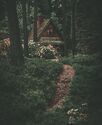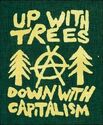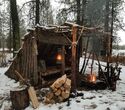Forestpunk is an aesthetic that is in the naturecore family. It is similar to cottagecore in its high regard for nature and mutual support. However, forestpunk is less restrictive of technology, particularly solar-powered items.
Forestpunk also diverges from other related aesthetics in its inspiration & timeframe. Where Cottagecore is derived from a romanticization of a European rural lifestyle, forestpunk-like styles have and still are present in several cultures around the world. (Examples include the Nordic, Uralic, Roma, Celtic, Siberian, Austronesian, Subsaharan, Aborigine, and Native American peoples.)
As long as there's a forest element to it, you've spotted a good inspiration, be it clothing or farming. While the examples mentioned earlier are good guides, take a look at the image on the right for more modern inspiration.
For example, a cabin in the middle of the woods, surrounded by vines & trees, living off rainwater & produce, feeding toads & deer while collecting their bones for decoration. Or, an apartment with solar panels with plants dotting the walls, rocks & buttermoths moving around, buying locally & dressed in greens & light browns. Goals are not only flexible, but each person makes their own based on acting feral and surviving in the wild.
There is some overlap with Cryptidcore due to the more feral nature of the aesthetic, Mossy for obvious reasons, and Goblincore due to the recollection of mosses, rocks, and plants used for decoration (in non-harmful ways to the environment) being a widespread practice.
Activities[]
Like with Cottagecore, there is a certain set of lifestyle aspects that go hand-in-hand with the aesthetics, such as:
- Hunting
- Fishing
- Trapping
- Wood carving
- Chopping firewood
- Bird calling, howling
- Tree climbing
- Collecting
- Building
- Sculpting
- Hiking
- Swimming
- Exploring
- Having a walk in a forest
- Regular foraging for food
- Gardening for fruits, veggies, fungi and condiments
- Zero waste
- Carbon-neutrality
- Rainwater use
The last three are of particular importance, as environmental preservation and restoration are two of the original reasons for the creation of the term 'forestpunk.'
Fashion[]
Dark greens, browns, and (some) light blues are quintessential to the clothing style associated with this aesthetic, with baggier clothing items being a suggestion but not a must. Some items to base a wardrobe are:
- Beanies
- Light blouses
- Long-sleeved shirts
- Sweaters
- Slim-to-skinny jeans
- Straight leg jeans
- Light jackets
- Boots (non-rubber)
- Solid-color fabric sneakers
- Long coats
- Denim overalls
- Hiking boots (like Timberlands)
- Flannels
- Heavy coats
- Corduroy jackets
- Round-beaded jewelry
- Chains
- Caps
- A-line skirts
Fur clothing is not unheard of, but because of the importance of being in harmony with nature, faux-furs are the preferred option. Light pendants are optional, and can be substituted with round, solid-color earrings (usually black).
Interiors[]
While a forestpunk living space itself is ideally a treehouse, this is not necessary, and an earthy vibe can be achieved with the correct placement and styling of furniture and other trinkets. Colours to include are those from the clothing style, though white is more present to give harmony to the walls and ceilings. Things to consider when decorating a room are:
- Balance empty spaces with decorative spaces. The woods are ordered on their own chaotic way, dotted with clearings & twisty groves.
- Plants, mosses, and rocks are, for obvious reasons, essential
- Bones
- Lighting is important, but bear in mind the mid-shadow that reaches the forest floor and use that image to use curtains and lightbulbs appropriately
- A small-to-mid-sized gardening area is good, but keep in mind preserving native vegetation
- Remember: plants, mosses, and rocks
- A wildlife feeder will let you see and interact with, well, wildlife!
- Did I already mention plants, mosses, and rocks? Anyway, yeah, plants, mosses, and rocks
Music[]
Acoustic instruments are common but not necessary. Guitars & relatives are common, coupled with nebulous lyrics (though lyrics themselves are not necessary). As with literature, woods & similar themes are common. Analogies are often used (again, with references to bones or nature).
Overall, as long as it gives a certain boscage vibe, it can be described as forestpunk.
Some examples of such songs are:
- Broken Crown — Mumford & Sons
- The Moon Will Sing — The Crane Wives
- Meet Me in the Woods — Lord Huron
- Walpurgisnacht — FAUN
- Boreas — The Oh Hellos
- Willow Tree March — The Paper Kites
- The Moss — Cosmo Sheldrake
- Fjörgyn — Osi and the Jupiter
- Forest Hymn — Averno
- Home — AURORA
- In The Woods Somewhere - Hozier
Playlists[]
- Forestpunk (folklore and evermore by taylor swift) by miraya ☁
- Cottagegore | dark naturalism | gloomcore | forestpunk [Spotify] by Triopse | Captain Drown
- Cottagegore | dark naturalism | gloomcore | forestpunk [YT] by Triopse | Captain Drown
Written[]
Usually, settings involving the woods are most of what you'll need for your forestpunk-themed literature. Alternatively, plots relating to hunts or some other dark, foggy plot starters are good calls. Categories include, but are not limited to, mystery, fantasy, & history. Here are some examples:
- The Only Good Indians by Stephen Graham Jones
- The Darkest Part of the Forest by Holly Black
Politics[]
Because of its greater focus on ecology & sustainability, forestpunk is invariably linked with green politics and environmental movements, as well as various equality movements. Forestpunk, like most other aesthetics based on nature & mutual aid, is related to anti-capitalist and anarchist movements, particularly green anarchy[Footnote 1] and indigenous movements. Equality is fundamental to forestpunk, and discrimination is heavily opposed in the community, with a clear distancing from supremacist & "traditional value" groups.
Gallery[]
Notes[]
- ↑ See zone à défendre, the Zones to Defend in France
















